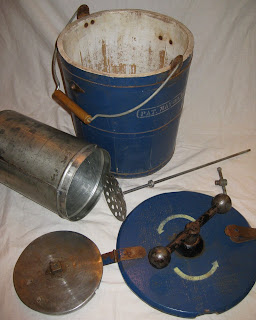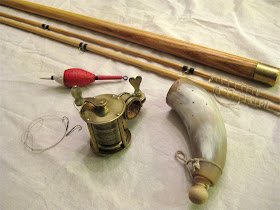 |
Mid 19th Century Image of Average Men
Un-named Source |
This post will focus on my journey to eventually recreate an accurate copy of a typical Frock Coat. These once commonplace, universal garments, were worn by farmers and statesmen alike but are virtually unobtainable to today's historian / reenactor with the exception of the few that are being made by competent tailors. Just to be clear on what I'm talking about, it's not the ill-fitting, shapeless impostor that we see so often today, but the carefully constructed and often fitted Frock Coat of the Mid-19th Century. The key to understanding what a Frock Coat is all about can only come from studying original examples. I know this places limitations on the curious student but many institutions have original Frock's in their collections and the extra effort to track one down is well worth it.
Let me start this with what it took for me to gain the confidence to pull off a fairly decent coat. Right off the bat, I knew I needed an authentic pattern and I immediately discovered that none had been developed. There is a very good reason why no one has marketed a successful pattern for a Frock Coat yet, it's just too darn hard. Besides being nearly impossible to size it to all the different shaped men out there, it would have to come with a book on period tailoring techniques, written by someone who had the patience to teach us amateurs.
 |
19th-Century Men
or Modern Impersonators ? |
It all started for me around 1991-'92 when I heard from Saundra Altman, of
Past Pattens, that a lady named Nancy Torgerson, had successfully drafted a pattern from a documented 1852 Frock Coat and made a replica example as well. Nancy was a tailor from Illinois with some renown in the history world, so I thought it was worth a shot. After considerable correspondence and a chunk of change, she parted with a copy of the pattern. The only unfortunate thing was that she hadn't drafted the pattern in the original size but instead had enlarged it for her client. A little problem but not insurmountable. At least I had something genuine to start with and with the purchase of some wool, I forged ahead. With a crash course on tailoring from a dated Simplicity sewing book I jumped ahead and created my first coat. It was mostly machine sewn and lined with polished cotton in a lovely shade of dark blue to match the blue wool. Okay, so it wasn't a winning replica of the original and it didn't fit all that well but it was a starting point and I learned a lot. Mostly what I learned was that I had a long way to go.
 |
| Gathered data and samples |
The next step along the way was the opportunity to study an original late 1850's Frock in the California State collections in Sacramento. I had recently become a volunteer at Columbia SHP and my membership allowed me access. Man did I learn from that coat. I sketched and photographed every detail. One thing that stood out was the fineness of the wool broadcloth and the amazing details in every part of the coat's construction. Was I in for it, the work would be consuming but my confidence was building. I started to formulate a philosophy about all of this "drive for authenticity"and promised myself that I would not cut corners but take the time to gather info, experience and the proper materials before my next attempt.
What followed over the next few years was a succession of events and serendipitous opportunities that would eventually lead to a successful coat. First, I found some wonderful black wool broadcloth from the
Pendleton Mills in Oregon. It had the finish, hand and density that came very close to the original. It didn't unravel when cut and that was a big plus. Next came Saundra Altman's workshops at Columbia in 1994 and later. One of my projects at the workshops was making a winter paletot under the watchful eye of Roxy Barber. Roxy had come to the classes as a guest of Saundra because she was a professional tailor. From Roxy, I learned about how garments were built from the inside out. She was a great teacher of pad stitching and the use of Interfacing, Underlining and Interlining to gain the correct form in the finished garment.
 |
| Muslin fitting from 1849 Tailor's Sheet |
Next in this process of gathering, was the unexpected gift of an original pattern draft of a Frock Coat from a rare 1849 tailor's sheet. The best part was that the muslin tester I made from that draft actually fit me. If that wasn't enough luck, some time after, I had the opportunity to trade for an original mid-century Frock Coat and a little later purchased another similar example at an antique shop in Amador City. One of the coats qualified as a study piece with opened seams and several large moth holes that I saw as "windows of opportunity". So now I had an authentic pattern, a nice piece of wool broadcloth and original coats to study. Continuing my quest for proper materials, I found a nice wool / cotton jean for the Underlining, from
Family Heirloom Weavers and dyed it madder red, as the originals. The proper weight of tow from the same source made for a nice Interfacing and a high quality wool batting from
Hobb's Heirloom would serve as my Interlining. The batting was nice and thin so I could layer it for shaping where needed. Even though most coats of the era were lined in mixed-weave fabrics that would show their silk facings, I opted for black silk taffeta from
Thai Silks. Brown polished cotton from
County Cloth worked out perfect for pocket linings. From Mill End Fabrics in Reno Nevada, I scored a beautiful cotton sateen for sleeve lining.
 |
| One of our original 1850's Frock Coats |
I hope that those that read my posts will refrain from judging me as some kind of elitist but part of my personal dabbling into the past is to enjoy it on my terms with no apologies. I choose to hand sew my garments because I enjoy it. It doesn't make them any better than the next guy's effort, just makes them more fun for me. With that said, I used Kinkame Silk #50 for construction and #30 for my buttonholes, from
Britex in San Francisco. Linen thread worked best for the inner construction and sleeve linings. By now it's 2003 and I can finally start my coat project.
Just a couple of little details need mentioning. With the quality of the wool that I was using, I had the opportunity to take advantage of some period details that I learned from studying the original coats. When it came to constructing the finished edges of Frocks, the tailors would turn under the seam allowances on the top only and cut the under piece to the edge. The raw edge of the under piece would be carefully edge stitched down. What you gained from this was only 3 layers of fabric instead of 4 and would give you a thinner edge, that was desirable. The other point I thought worth mentioning was that the hem on the skirt was left raw as well. To give the hem some body, they rolled up the lining to form a corded edge effect, on the inside of the skirt hem. All in all, I was very pleased how it turned out. I'm the last person to claim any expert status when it comes to recreating period dress but from my experience, here is my formula for success in trying to duplicate a Frock Coat. All I can say is Good Luck and keep trying , it's a tough nut to crack.
1. Find the best possible materials
2. Use an authentic pattern, drafted from an original source
3. Learn and practice basic tailoring techniques
4. Study original coats
5. Make a fitted muslin and correct to fit, this will be your final
pattern
6. Make the commitment to not cut corners.
|
My Replica Frock Coat
Photos Lindy Miller 2011 |
 |
| Rear View |
 |
| Front View Closed |
 |
| Side View |
For those that read to the bottom of my posts, the collodion image of the impersonators



























